Introduction: In November
1914, a German landing party from the SMS Emden attempted to put out of action the cable station on Direction
Island, one of the Cocos
(Keeling) Islands, now part of Australia. The State Library of New South Wales has a photo album from R.H.C. Green, Superintendent of the Cocos cable and wireless station showing scenes following the attack.
While
the landing party was still ashore, the Emden was attacked by an
Australian light cruiser, HMAS Sydney, and ran aground on North Keeling Island (where its remains
still lie today). Marooned on Direction Island, the officer in charge
of the landing party, KapitänLeutnant (First Officer) Hellmuth von
Mücke, commandeered the schooner Ayesha which was moored in
the lagoon, and sailed it with his crew to the Dutch East Indies. There
they boarded a German steamer to Turkey, then travelled overland by a
circuitous route to Germany, where they arrived after many adventures
seven months after leaving Cocos.
While
still at war, von Mücke wrote a book about this arduous voyage, titled The “Ayesha”, being the Adventures of the Landing Squad of
the “Emden”, which was translated into English by Helene
S. White and published in the USA in 1917. The first part of the book
describes the landing on Direction Island and the destruction of the wireless and cable
equipment, and is reproduced below.
|
Telegraph Museum Porthcurno produced this short video in July 2019 on SMS Emden and the attempted destruction of the Eastern Extension, Australasia & China Telegraph Company’s cable station:
Bill
Glover sets the stage for the events which became known as the Battle of Cocos:
The Cocos (Keeling)
Islands consist of 27 coral islands situated between latitudes 11°
49' and 12° 12' S and longitudes 96° 49' and 96° 56' E.
They were discovered in 1609 by Captain William Keeling, a Royal Navy
commander and agent of the East India Company, while returning to England
with a convoy from the Dutch East Indies.
The islands remained
uninhabited until 1826 when Alexander Hare, a former East India Company
official, arrived and settled on Direction Island with a group of Malays.
The following year a former trading partner of Hare and former East
India ships captain, John Clunies Ross, arrived with his wife and family
and a number of Malay seamen, who formed a settlement on Home Island.
The trading partnership had not been very successful and problems soon
arose between the two groups. After eight years of discord Hare decided
to leave and moved to Batavia. John Clunies Ross died in 1853 and was
succeeded by his son John George Clunies Ross.
In 1857 the Admiralty
issued Captain Fremantle of HMS Juno instructions to annex the
Cocos Islands. Clunies Ross was appointed Governor by Fremantle and
later the British Government gave the Clunies Ross family perpetual
lease of the islands.
The Clunies Ross
family established coconut plantations on the islands, building up a
successful business dealing in copra which they transported, in their
own schooner, to Batavia for onward transmission to London or Hamburg.
They carried mail to and from Batavia as well as supplies.
When it became clear
that the Pacific cable would go ahead the Eastern Extension, Australasia
& China Telegraph Company decided to improve its service to Australia.
It leased land on Direction Island from the Clunies Ross family, building
a cable station on the site. The new cable route was Durban - Mauritius
- Rodriguez Island - Cocos - Perth and Adelaide.
On the morning of
9 November 1914, cable station staff on Direction Island saw a warship
approaching. Having been warned about SMS Emden the wireless
operator sent out a message. “Strange warship approaching.”
This was soon followed by “SOS! Emden here.” These
messages were picked up by a passing troop convoy and one of the escorts,
HMAS Sydney, was despatched at full speed.
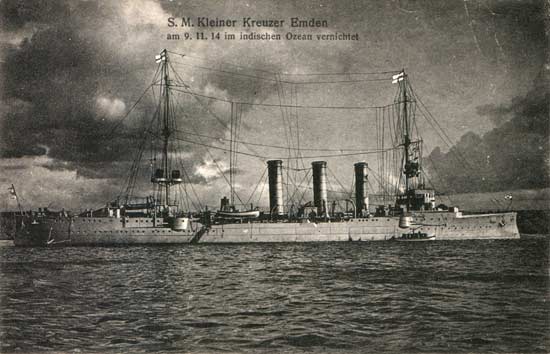
SMS Emden, 9 November 1914 |
The Captain of SMS Emden, Fredrich von Muller, sent a landing party of fifty men and
officers with instructions to destroy equipment and cut the cables.
Emden’s steam launch and two cutters were used to ferry the party
ashore. The station staff were rounded up and placed under guard while
the rest of the landing party set about destroying instruments and trying
to cut the cables. They succeeded with the Perth cable but failed with
the one to South Africa.
While this was going
on the crew remaining aboard Emden saw smoke on the horizon and
assumed it was their collier Buresk. Realising that the vessel
approaching was a warship they weighed anchor and signalled the landing
party to return. Unable to reach the Emden, the landing party
headed for the Clunies Ross schooner Ayesha, anchored in the
lagoon. They sailed Ayesha to the Dutch East Indies, where they
boarded a German steamer which took them to Turkey. From Turkey they
travelled overland, reaching Germany seven months after leaving Cocos.
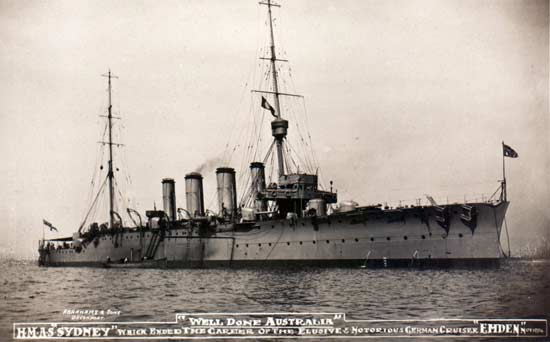
“Well Done Australia”
HMAS Sydney which ended the career of the elusive
&
notorious German Cruiser Emden Nov 1914 |
The first salvo
in the battle was fired by Emden at 9.40 am. This caused damage
and casualties aboard Sydney. It was twenty minutes before Sydney
scored a major hit, but from then on it was only a matter of time. The
battle ended at 11.15 am. when Captain Muller ran the Emden aground
on North Keeling Island.
For more background information
see Bill Glover’s Cocos
(Keeling) Island stamps page
|

75th
anniversary souvenir sheet showing
the
engagement of the Sydney
and the Emden
|
This photograph of the wreckage of the Emden and the further set at the end of the page are courtesy of John Boyd, whose great uncle, Robert Langley Boyd, was a cableship captain from the 1890s until the 1930s. The photographs have come down in the family, but it is not known if they were taken by Captain Boyd.
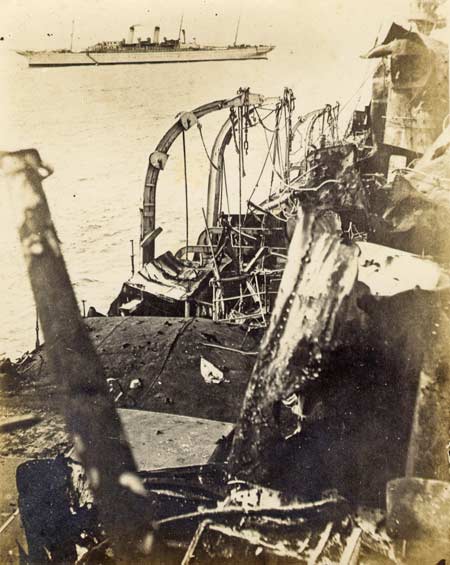
Inscribed on the reverse:
Wreckage of the Emden
H.M.S. Sydney in distance |
Despite the caption, examination of an enlarged view of the distant ship shows that it is not the Sydney. It is believed to be RMS Empress of Japan, a liner converted to an auxiliary cruiser in 1914 after the start of the war, which is recorded in various references as having been on the scene.
See the comparison below of the ship in the Emden wreck photo (top) and the Empress of Japan (bottom): |
While these events
were unfolding at sea, First Officer von Mücke was ashore:
THE
“AYESHA”
CHAPTER
I
KEELING
ISLAND
“I report for
duty the landing squad from the ship, - three officers, six petty officers,
and forty men strong.”
|
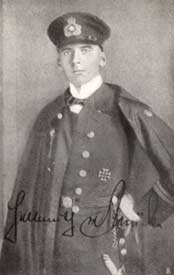
KapitänLeutnant
Hellmuth von Mücke
|
It was on the ninth
of November, 1914, at six o'clock in the morning that I reported for duty
to the commanding officer of his Majesty’s ship, “Emden,” Captain
von Mueller, at the gangway of the ship. The “Emden” was lying
at anchor in Port Refuge, a harbor formed by Keeling Reefs. Alongside
were the two cutters in which the officers and men of the landing squad
had already taken their places. The steam launch was ready to push off
and tow them ashore. My orders were to destroy the wireless telegraph
and cable station on Direction Island, which is the most northerly island
of the Keeling group, and to bring back with me, in so far as possible,
all signal books, secret code books, and the like.
Three cables run
from Direction Island, one line to Mauritius, another to Perth in Australia,
and a third to Batavia. As this station was the last absolutely British
connection between Australia and the motherland - the other cables having
been cut by some of the other ships of our cruising fleet - we had every
reason to suppose that we would meet with vigorous military resistance.
For this reason we were taking with us all of the four machine guns that
the “Emden” carried. Two were aboard the steam launch, the others
had been put on the cutters. The men were equipped with rifles, side arms,
and pistols. The launch took the cutters in tow, and we were off for Direction
Island.
Even quite small
boats must pick their way very carefully while within the waters of this
atoll, in order to avoid the numerous, constantly changing coral reefs.
The course that we were to take from the ship to the point at which we
were to land, covered a distance of about 3000 meters.
Direction Island
is very flat, and is covered with a luxuriant growth of tall palms. Among
their towering tops we could discern the roofs of the European houses
and the high tower of the wireless station. This was our objective point,
and I gave orders to steer directly for it. Just below our landing place
a small white sailing vessel was riding at anchor.
“Shall we destroy
that, too?” inquired one of my lieutenants, pointing to the little
schooner.
“Certainly,”
was my answer. “It has sailed on its last voyage. Detail a man at
once to be ready with the explosive cartridges.”
With our machine
guns and firearms ready for action, we landed at a little dock on the
beach, without meeting with resistance of any kind, and, falling into
step, we promptly proceeded to the wireless station. The destruction of
the little white sailboat was deferred for the time being, as I wished
first of all to find out how affairs on shore would develop.
We quickly found the telegraph building and the wireless station, took
possession of both of them, and so prevented any attempt to send signals.
Then I got hold of one of the Englishmen who were swarming about us, and
ordered him to summon the director of the station, who soon made his appearance,
- a very agreeable and portly gentleman.
“I have orders
to destroy the wireless and telegraph station, and I advise you to make
no resistance. It will be to your own interest, moreover, to hand over
the keys of the several houses at once, as that will relieve me of the
necessity of forcing the doors. All firearms in your possession are to
be delivered immediately. All Europeans on the island are to assemble
in the square in front of the telegraph building.”
The director seemed
to accept the situation very calmly. He assured me that he had not the
least intention of resisting, and then produced a huge bunch of keys from
out his pocket, pointed out the houses in which there was electric apparatus
of which we had as yet not taken possession, and finished with the remark:
“And now, please accept my congratulations.”
“Congratulations!
Well, what for?” I asked with some surprise.
“The Iron Cross
has been conferred on you. We learned of it from the Reuter telegram that
has just been sent on.”
We now set to work
to tear down the wireless tower. The men in charge of the torpedoes quickly
set them in place. The stays that supported the tower were demolished
first, and then the tower itself was brought down and chopped into kindling
wood. In the telegraph rooms the Morse machines were still ticking busily.
What the messages were we could not decipher, for they were all in secret
code. But we chuckled with both amusement and satisfaction as we pictured
to ourselves the astonishment of the senders, who were waiting in vain
for a reply to their messages, for, from the vigorous action of the apparatus,
we concluded that some information was eagerly desired. But this, to our
regret, it was not in our power to furnish.
Our next duty was
quite to the taste of my vigorous boys in blue. A couple of heavy axes
were soon found, and, in a few minutes, Morse apparatus, ink bottles,
table legs, cable ends, and the like were flying about the room. “Do
the work thoroughly!” had been our orders. Every nook and corner
were searched for reserve apparatus and other like matter, and everything
that bore any semblance of usefulness in a wireless station was soon destroyed.
Unfortunately this fate was shared by a seismometer that had been set
up on the island. In their zeal my men had mistaken it for a lately invented
addition to the telegraph service.
To locate and cut
the submarine cables was the most difficult part of our task. A chart,
showing the directions in which the cables extended, was not to be found
in the station, but close to the shore we discovered a number of signboards
bearing the inscription, “Cables.” This, therefore, must be
the place where we must search for the ends of the cable strands. Back
and forth the steam launch carried us over the cables that were plainly
to be seen in the clear water as we tried to grasp them with a couple
of drags and heavy dredging hooks, which we drew along the bottom. It
was no light task, for the cables were very heavy, and the only power
at our command was a very limited amount of human strength. For a while,
it seemed impossible to draw the cables to the surface; in the end, after
we had succeeded in raising the bight of the cable a little, my men had
to get into the water, dive, and tie tackle to it, by the aid of which
we continued our labor. With great difficulty we at length succeeded in
getting the cable strands into the boat. I did not want to use any of
the dynamite cartridges for the work of destruction, as the “Emden”
might have need of them for the sinking of more steamers. So we set to
work upon the stout cables with crowbars, axes, driving chisels, and other
like implements. After long and weary labor, we succeeded in cutting through
two of them, and we then dragged the ends out to sea, and dropped them
there. The third cable was not to be found in spite of our diligent search
for it.
A small house of
corrugated iron, in which were stored quantities of reserve apparatus
and all sorts of duplicate parts, was blown up and set on fire with a
couple of explosive cartridges. All newspapers, books, Morse tapes, and
the like, we took away with us.
Our landing squad
was just about to re-embark when, from the “Emden,” came the
signal “Hurry your work.” I quickly summoned my men, abandoned
my intention of blowing up the small white schooner as a matter of little
importance, and was on the point of pushing off from shore, when it was
reported to me: “The 'Emden' has just sounded her siren.” This
was the command to return to the ship with the utmost despatch. As I was
boarding the steam launch, I saw that the anchor flag of the “Emden”
was flying at half mast, which told us that she was weighing anchor. The
reason for this great haste was a mystery to me, and, for the present,
was no concern of mine. All my effort was bent upon getting back to the
ship as speedily as possible. With all steam on we raced toward the “Emden,”
taking the shortest course between the reefs.
Meanwhile, the “Emden”
had turned seaward, and was running at high speed out of the harbor. My
first thought was that she was going to meet our tender, the “Buresk,”
that had been ordered here with coal, and which, I supposed, she was going
to pilot through the reefs. In this belief I continued to follow the “Emden”
as fast as I could, but was surprised to find her going at a speed of
from sixteen to seventeen miles. Our launch, with the heavily laden cutters
in tow, could make barely four miles an hour.
Suddenly we saw the
battle flags on the “Emden” run up, and then a broadside burst
from her starboard. Even yet the reason for all this was hidden from me,
and I believed the “Emden” to be in pursuit of a steamer that
had come in view.
But now a salvo of
five heavy shells struck the water just aft of the “Emden”;
five tall waterspouts marked the places where they fell into the sea.
There was no longer any room for doubt; we knew that a battle was on in
earnest. The “Emden’s” opponent we could not see, for the island,
with its tall palms, was between us. The “Emden,” in the meantime,
had increased her distance from us to several thousand meters, and was
adding to her speed with every moment. All hope of overtaking her had
therefore to be abandoned, and I turned back.
CHAPTER
II
THE
“AYESHA”
We landed at the
same place at which we had gone ashore before. Again I ordered all the
Englishmen to assemble, and their firearms were taken from them. The German
flag was raised on the island, which was declared to be under martial
law; every attempt to communicate by signal with any other island, or
with the enemy’s ships, was forbidden; my officers were given orders to
clear the beach for defence, to mount the machine guns, and to prepare
to intrench. Should the engagement between the two ships prove to be a
short one, I could count with certainty upon the enemy’s cruiser running
into port here, if for no other reason than to look after the station.
It was not my intention, however, to surrender without a blow an island
on which the German flag was flying.
The Englishmen on
the island were little pleased at the prospect, and begged permission,
in case it should come to a battle, to withdraw to one of the other islands.
Their request was granted.
Accompanied by two
of my signal men, I now took my station on the roof of the highest house
to watch the fight between the two cruisers. As a whole, the Englishmen
showed little interest in the conflict that was going on but a few thousand
meters distant from the island. Other matters seemed to claim their attention.
With an ingratiating smile one of them stepped up to our officers, who
were head over ears in work down on the beach, and asked:
“Do you play
tennis?”
It was an invitation
which, under the circumstances, we felt compelled to decline.
By the time I had
reached the roof, the fight between the “Emden” and the other
cruiser was well under way. I could not identify the enemy’s ship, but,
judging from her structure, and the amount of water raised by the falling
shells, I concluded that it must be one of the two Australian cruisers,
the “Sydney” or the “Melbourne.” As the columns of
water raised by the enemy’s shells were much taller than those caused
by the “ Emden’s,” I estimated the guns of the enemy to be of
15 centimeter caliber.
The “Sydney,”
for she it was, as I learned later, was more than a match for the “Emden.”
Our ship of 3600 tons displacement could deliver a broadside of only five
10½ centimeter guns, and had no side armor, whereas the “Sydney,”
being a vessel of 5700 tons displacement, could fire a broadside of five
15.2 centimeter guns, and had armored sides. From the very beginning,
the “Emden’s” fire reached its mark on the enemy’s cruiser,
whose guns, it must be said, were aimed pretty badly. The water spouts
that were raised by their falling shells were mostly several hundred meters
distant from one another. But when one of the volleys did hit, it made
havoc on our unarmored vessel.
During the very first
of the fight, the forward smoke stack of the “Emden” was shot
away and lay directly across the deck. Another shell crashed into the
stern aft of the cabin, and started a great blaze, the gray smoke of which
was mixed with white steam, showing that the steam pipes had been damaged.
The “Emden” now turned sharply about and made a dash for her
foe, apparently for the purpose of making a torpedo attack. It cost her
her foremast, which was shot away and fell overboard. For the moment it
seemed as though the enemy’s ship intended to discontinue the fight, for
she turned and ran at high speed, followed by the “Emden.” Whether
the “Sydney” had suffered serious damage which could not be
discerned from without, I could not tell. Perhaps it was simply her intention
to increase her fighting distance from the “Emden,” in order
to take advantage of the greater caliber of her guns.
The running fight
between the two ships now took a northerly course at an ever increasing
distance from the island, and soon the two cruisers, still fighting, were
lost to view beyond the horizon.
The point for me
to settle now was what to do with the landing squad. So far as our ship
was concerned, the damage she had suffered at the hands of a far superior
foe was so great that a return to the island, even in the event of a most
favorable outcome of the battle, was out of the question. She must run
for the nearest port where she could make repairs, bury her dead, and
leave her wounded. At the same time I could count with certainty upon
the arrival of an English war vessel ere long in Keeling harbor, to learn
what had befallen the cable and wireless station. For, had not the telegraphic
service to Australia, Batavia and Mauritius been cut off entirely?
With our four machine
guns and twenty-nine rifles we could, for the time at least, have prevented
the English from making a landing on the island, but against the fire
of the English cruiser’s heavy guns, which would then have been directed
against us, we would have had no defence whatever. Taking everything into
consideration, therefore, we could do no more than defer the surrender
of a position that, from the outset, it had been impossible to hold. Moreover,
confinement in an English prison was little to our taste.
Now, fortunately
for us, the small white schooner that we had failed to blow up was still
riding at anchor in the harbor. It could, and it should help us to escape
from our predicament. I decided to leave the island on the little boat.
Her name was “Ayesha,” and at one time she had served to carry
copra from Keeling to Batavia two or three times a year, and to bring
provisions back with her on her return trip. Now that steamship service
had been established between these two points, she lay idle and dismantled
in the harbor, and was gradually falling into decay.
|
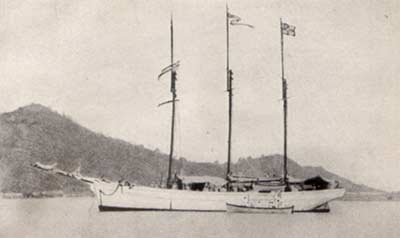
The
“Ayesha”
|
Taking no one with
me, I got into the steam launch and went out to the schooner to learn
whether she was at all seaworthy. The captain and a single sailor were
aboard her. Of the former I inquired casually whether he had any ammunition
aboard, for I did not wish him to suspect the real purpose of my coming.
He said there was none, and a brief inspection of the ship led me to believe
that she was still seaworthy. Consequently I sent my officers and men
aboard the “Ayesha” to get her into trim for sailing.
There was plenty
to do on the little ship. All the sails and rigging had been taken down
and stowed away, and had now to be put in place again..
When the Englishmen
on the island realized that it was my intention to sail off in the schooner,
they warned me with great earnestness against trusting ourselves to her,
saying that the “Ayesha” was old and rotten, and could not stand
a sea voyage. Furthermore, they informed me that an English man-of-war,
the “Minotaur,” and a Japanese cruiser were in the vicinity
of the island, and that we would surely fall a prey to one of them.
As my predecessor
in command of the “Ayesha” was leaving her, he wished us Godspeed,
and concluded with the comforting remark, “But the ship’s bottom
is worn through.”
When, in spite of
all these warnings, we remained firm in our purpose, and continued the
work of getting the “Ayesha” ready for sea, the sporting side
of the situation began to appeal to the Englishmen, and they almost ran
their legs off in their eagerness to help us. Could it have been gratitude
that impelled them to lend us their aid? It is a question I have never
been able to answer to my satisfaction, although, to be sure, several
of them did express a feeling of relief at the thought that now the fatiguing
telegraph service with its many hours of overwork, and its lack of diversion,
was a thing of the past. They showed us where the provisions and water
were kept, and urgently advised us to take provisions from the one side,
where they were new and fresh, rather than from the other, where they
were stale. They fetched out cooking utensils, water, barrels of petroleum,
old clothes, blankets, and the like, and themselves loaded them on trucks
and brought them to us. From every side invitations to dinner poured down
upon us; my men were supplied with pipes and tobacco; in short, the Englishmen
did all they could to help us out.
Nor were they sparing
with advice as to the course we ought to take, and time proved that all
they told us of wind and weather, of currents, etc., was in every way
trustworthy. As the last of our boats left the shore, the Englishmen gave
us three hearty cheers, wished us a safe journey, and expressed their
gratitude for the “moderation” which we had shown in the discharge
of our duty, wherein all of our men had behaved “generously,”
they said. Then, cameras in hand, they still swarmed about the “Ayesha,”
taking pictures of her.
Meanwhile the lookout
on our ship reported that the two battling cruisers had come into sight
again. From the top of the “Ayesha’s” mast I could at first
see only the thick cloud of black smoke that the “Sydney’s”
smoke stack was belching forth, but soon the masts, smoke stacks and upper
deck came in sight. Of the “Emden” I could see only one smoke
stack and one mast; the rest of the ship was below the horizon. Both cruisers
were steering an easterly course, and both were still firing their guns.
Suddenly, at full
speed, the “Sydney” made a dash at the “Emden.” “Now,”
thought I, “the 'Emden’s' last gun has been silenced, and the `Sydney'
is running at her to deal her her death blow.” But then, in the black
smoke of the English ship, between the foremast and the nearest smoke
stack, a tall column of water shot up, which could only be the result
of a serious explosion. We supposed that it was caused by a well-aimed
torpedo shot from the “Emden.” The “Sydney,” which
was still running at a speed of twenty nautical miles, now made a quick
turn to starboard, changed her course entirely, and steamed slowly westward.
The “Emden” continued to steer an easterly course. Both ships
were still firing at each other, but the distance between them grew greater
and greater, until finally they were beyond the reach of each other’s
guns. The fight was over. In the approaching darkness both vessels were
soon lost to sight beyond the horizon. That was the last we saw of them.
The conflict, which had begun at about 8.30 in the morning, ended at six
o'clock in the evening. The report, published in all the English newspapers,
that it was only a “sixty minutes’ running fight” is therefore
to be classed with the many similarly false reports made by the English.
The oncoming darkness
now warned me to make my way as speedily as possible out of the harbor,
for the dangers of the coral reefs render it unsafe for navigation after
nightfall. In the meantime we had taken aboard water enough for four weeks,
and provisions for eight. The sails had been bent on as best they could
be. I made a short speech, and with three cheers for the Emperor, first
in command, the war flag and pennant fluttered up to the masthead of his
Majesty’s latest ship, the schooner “Ayesha.” Slowly the steam
launch took us in tow. I climbed to the top of the foremast, as from there
I could best discern where lay the reefs and the shoals, for of charts
we had none. With the boatswain’s whistle I gave the launch orders to
steer to starboard or to port, according to the lay of the reefs. The
“Emden’s” two cutters we carried in tow.
Our departure was
much too slow to suit us. The sun was setting, and in these latitudes,
so near the equator, there is no twilight. No sooner has the sun disappeared
below the horizon than the blackness of midnight reigns. We had not passed
quite through the danger zone of the reefs before it grew so dark that,
from my position on the foremast, I could not see ahead sufficiently far
to direct our course. In order to be able to see anything at all, I climbed
down into the port fore channels close by the water, and gave my orders
from there.
Just as we were passing
the last reef that might prove dangerous to us, we spent some anxious
moments. Suddenly, in spite of the darkness, I could see every pebble,
every bit of seaweed on the bottom, an unmistakable evidence that we were
in very shallow water. Our lucky star guided us over this shoal also,
however, and we did not run aground.
Meanwhile we had
set some sail, and had thus lightened the work of the steam launch, which
still had us in tow. Before long we were free of the sheltering islands,
and the long, heavy swells of the ocean put some motion into our new ship.
When we were far
enough out at sea to sail our boat without danger of running into the
surf to leeward, I called the steam launch back to the ship, so as to
take off the crew. The heavy swell made this manoeuvre no light task.
Again and again the little steamboat was dashed against the side of the
“Ayesha,” and, although the future of the launch was of little
interest to me, this unexpected encounter between my old ship and my new
one gave me serious concern. I had no confidence in the “Ayesha’s”
ability to endure with safety such vigorous demonstrations of friendship.
Finally, however, we succeeded in ridding ourselves of the steam launch
in this way: the last man aboard her started her engine again with the
little steam that was left in the boiler. Then, from aboard the “Ayesha,”
we reached over with a boat hook, and turned the rudder of the steam launch
to port. Courtesying elegantly, the little boat drew away from us, and
soon vanished in the darkness. Whither it went, I do not know. In all
likelihood it found a grave in the surf that beat wildly only a few hundred
meters away. Perhaps, however, it is still beating about the ocean, raiding
on its own account.
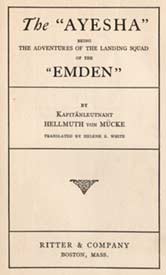 |
There is no further
mention of Direction Island or the cable station in the book, but the
story continues, chronicling the many hardships encountered by von Mücke
and his crew as they made their way back to Germany. As the translator
of this edition noted in her preface:
“That men placed
in almost daily peril of their lives can retain their sense of humor and
a kindly attitude toward men and circumstances throughout a desperate
struggle with adverse conditions is a happy testimony to the buoyancy
and to the superiority to the merely physical that courage in the face
of danger begets.
“Although always
bravely confident, there is an engaging ingenuousness and freedom from
self-conceit in Lieutenant von Mücke’s delightful recital of his
amazing achievement, while his never failing appreciation of the humorous
side of the situation illumines the entire narrative as with flashes of
sunshine.”
The wreckage of the SMS Emden
Images courtesy of and copyright © 2012 John Boyd |
 |
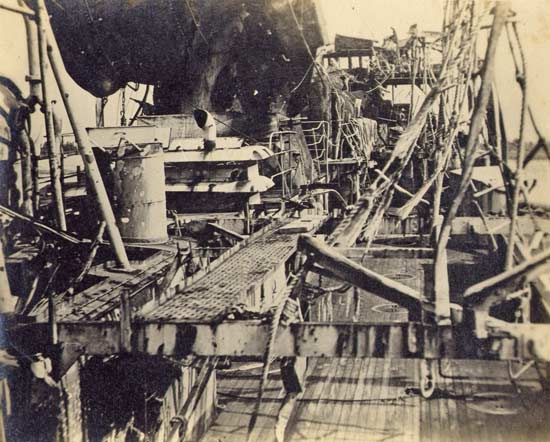 |
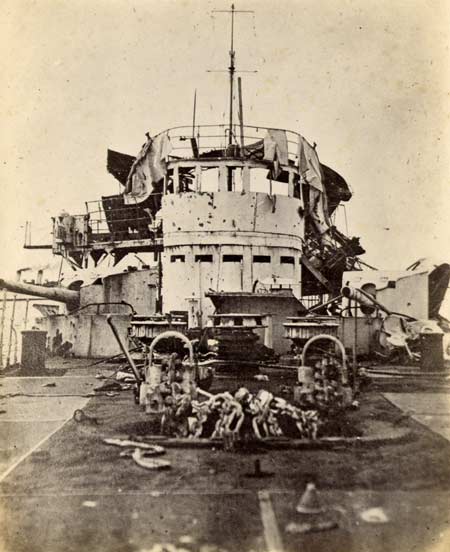 |
 |
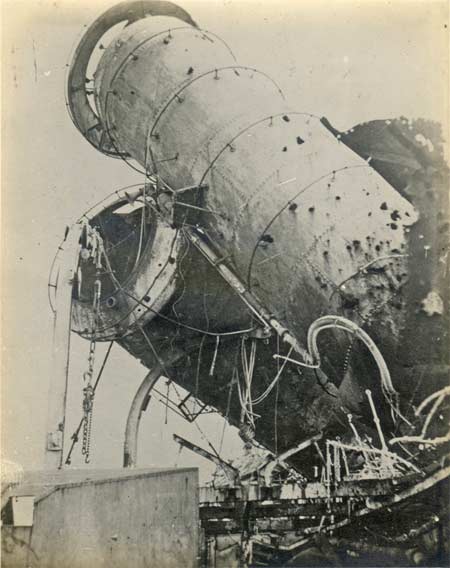 |
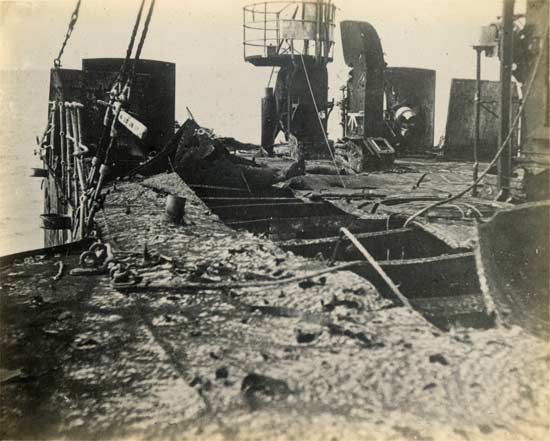 |
The Australian War Memorial website has a page on HMAS Sydney and the sinking of SMS Emden.
A medal commemorating the sinking was issued in Australia; the medals incorporated a portion of the Mexican silver dollars recovered from the Emden. |

